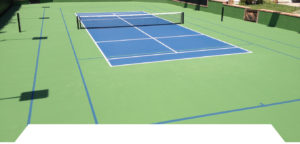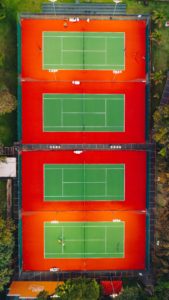
Have you been considering pickleball court construction for your home or business? If so, you can get the utmost in quality service and materials from Taylor Tennis Courts. We have four decades of experience in tennis court construction as well as the development and maintenance of other sports courts, and we can ensure that your pickleball court is meticulously installed with all the features you want and need to maximize enjoyment.
Pickleball is getting more popular than ever, and many courts are getting modified to accommodate it. New players, however, may not be aware of its origins as a game. This “sweet sport with a sour name” was invented in 1965 on an island outside of Seattle, Washington, called Bainbridge Island. Three fathers wanting to entertain their kids are credited with inventing the game. Joel Pritchard, Bill Bell, and Barney McCallum got creative with improvised equipment and simple rules to create what is now an explosively popular sport in North America. Today, European and Asian countries are also adding pickleball courts to their facilities.
One of the biggest questions people have about pickleball is, of course, the origin of the name. Interestingly enough, there are several different accounts as to its source. The two main accounts are as follows:
- Joel Pritchard’s wife, Joan, says she started calling the game pickleball because the combination of different sports reminded her of the pickle boat in rowing, the oarsmen of which are chosen from the leftovers of other boats.
- Barney McCallum claims the game was named after Pritchard’s dog Pickles, who would chase the ball and run off with it during games.
Whether you’re looking for pickleball court construction for your backyard, or you need a network of sport courts built to accommodate a variety of different games, Taylor Tennis Courts is more than happy to suit your needs. For more information about our sports court construction offerings, or to get a free, no-obligation estimate for your project, you can contact us today at (800) 558-3664.
 Do you need quality
Do you need quality 
